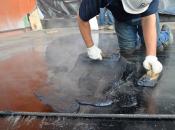Search
Login
Recommended
Roof leak, how to quickly and competently eliminate roof leak
In any house, sooner or later, the roof begins to leak. It's not even a matter of poor quality work and the wrong choice of materials. The reason, most often, is the ordinary wear of materials for the roof, because the shelf life of each of them has its limitations. You can fix leaks and repair the roof yourself, without resorting to the services of professionals. The main thing is to learn more about some of the features of your roof and act on this basis.
Content
- Types of roof
- Types of roofing materials
- What kind of roofing to choose video
- Types of soft roofing
- Causes of roof leakage and methods for eliminating leaks
- Do it yourself roof repair. Liquid roofing video
Types of roof
Absolutely all roofs can be divided into only two types - flat and pitched. Other designs have not yet been invented.
Flat roofs are most often used for large multi-story construction and construction of industrial facilities and large storage facilities. As a rafter and roofing material, various concrete products and slabs are used.

Pitched roofs are the most common structures for single-story and private construction of houses. For the installation of the rafter system, wood of different species or profile metal is used.

Types of roofing materials
The construction market is pleased with an extensive list of roof types for roofs. The choice here is limited only by price and own capabilities.
Slate. Sheets of asbestos-cement mixture are one of the most popular types of roofing material. They have high strength characteristics, fire resistance and it is quite easy to lay it on the rafters. It is produced in the form of wavy and flat canvases, with clearly defined dimensions.

Bitumen fiber. The most widely distributed material is Ondulin, which is the most popular representative of this type of roofing material. It is based on building cardboard, impregnated with a bitumen mixture. Cheap enough, but has a short life of no more than 10 years. Therefore, using it for the roof of the house is simply unreasonable.

Metal tile. One of the most reliable and popular roofing. It is a sheet of galvanized steel, which is coated on top with a special polymer coating. The weight of this type of material is very small, one m2 weighs no more than 6 kg, which allows it to be used even in light summer houses. The only drawback is the installation, for which you need a lot of additional elements and fixtures, allowing you to lay it as reliable as possible. Of course, you can do this with a hammer and nails, but then roof leaks and a short operational life are simply guaranteed.
Types of soft roofing
In addition to hard roofing, there are also soft types of roofing, which are deservedly popular. Many masters involved in construction at a professional level, they believe they are much more reliable and have a greater degree of protection against atmospheric influences.
Membrane roofing is made from polymer compositions. Due to its flexibility, plasticity and durability, it has become widespread in the construction of large industrial buildings and structures. It does not respond to seasonal temperature changes and has a rather long service life of about 20-35 years.

Soft tile. It is a multilayer product of various shapes. It is made of fiberglass, bitumen and polymers. As a result, strong and durable products are obtained that are not afraid of either high summer temperatures or winter cold.

Roll materials. Usually stacked on roofs by welding. They are made from bitumen-polymer mixtures and can be used up to 25 years. The basis for a rolled roof, most often serves as fiberglass, which has high strength characteristics and is one of the most reliable and common foundations.
Causes of roof leakage and methods for eliminating leaks
What causes the roof to flow? This question is surprisingly asked by homeowners who have recently covered the roof. There can be many reasons, here are just a few of them:
Shift of a fragment of the roof. Perhaps the reason is precisely this. It is necessary to carefully check the joints of the material and inspect all hard-to-reach corners. If a defect is found, it must be eliminated, the departed fragments carefully fixed.
Rust. Permanent exposure to moisture can cause irreparable harm to even the most durable and protected types of metal roofing. In this case, the repair of the roof must be done based on the nature of the damage. If most of the metal sheet is rusted, then it must be completely dismantled and replaced with a new one. If the damage is small, then it is quite possible to apply a patch, that is, weld a piece of sheet metal of the right size to the place of corrosion. If there are no metal sheets at hand, then you can make a temporary patch from a simple tin can.

Cracks. They can occur both in roofing material and in ceramic tiles. The main reason is incorrect roof waterproofing or its installation. In the case of tiles, the leak can be eliminated only by completely replacing the damaged element. With roofing material, everything is much simpler. A patch is applied to the problematic area, exceeding the size of the damage and is fixed using bitumen mastic or fusing. If the cause of the leak was bloating, then it is necessary to make a cruciform incision on the meta of the bubble and glue it again.

Even at the stage of construction and laying of roofing materials, it is necessary to provide for the possibility of repair. To do this, you need to leave a small supply of material, so that in the event of a leak, do not look for it specifically. If all materials are at hand, you can eliminate the leak within a few minutes.





